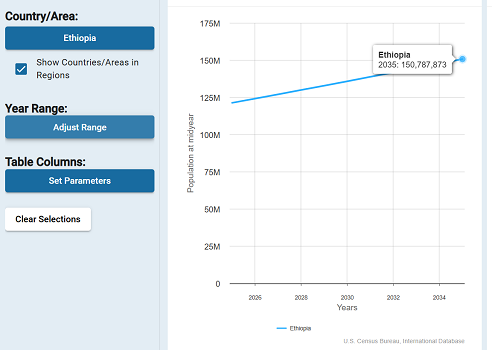The total population of Ethiopia is estimated to surpass 150 million after ten years by 2035, a new report said.
A new report, ‘Population Trends Across the Globe’, published today by US Census Bureau, shows that the total population of Ethiopia that will be (124.2 million in 2025), is estimated to reach 150.7 million by 2035. The data also shoes that the total population of the neighboring Sudan, which has now around 50 million population is estimated to reach about 66.4 million.
The U.S. Census Bureau produces population estimates and projections for over 200 countries and areas with populations of 5,000 or more that are publicly available on the International Database. These population estimates and projections show population trends that are unique to some countries and others that represent broader global shifts.
Today, the Census Bureau published revised estimates and projections for 34 countries or areas. The updates incorporate new population data and changes in demographic trends. Among them are Côte d’Ivoire, South Korea and Canada briefly covered in this article.
Côte d’Ivoire
Côte d’Ivoire’s total fertility rate (TFR) in 2024 is estimated at 3.9, which is higher than was previously projected. Côte d’Ivoire’s high level of fertility in 2024 shows a more gradual decline from very high levels of fertility, down 48% over the last 49 years from a TFR of 7.6 in 1975 to 3.9 in 2024.
This gradual decline is similar to the fertility picture in other countries in West Africa. It is projected that the fertility to continue to decline in Côte d’Ivoire and eventually reach a TFR of 2.1 in 2091.
Côte d’Ivoire also has high infant mortality. The 2024 estimate was 53 infant deaths per every 1,000 live births. Such high infant mortality also means a low life expectancy at birth. The 2024 estimate for the life expectancy at birth was 63.5 years compared to 84.7 in South Korea, 83.9 in Canada and 78.4 in Cuba.
Although mortality in Côte d’Ivoire is higher relative to many other countries, its current levels are dramatic improvements from the past.
Life expectancy at birth increased by 14.4 years from 49.2 in 2000 to 63.5 in 2024. This represents an average increase of more than half a year every year since 2000. These improvements were fueled by rapid reductions in infant mortality and declines in AIDS mortality among adults.
It is projected that the improvements in life-expectancy to continue but at a slower pace. In combination with high fertility and declining mortality, Côte d’Ivoire’s population is growing. Its population doubled from 1998 to 31 million people in 2024 and we project it will double again over the next 38 years to 62 million by 2062.
South Korea
The updated data on South Korea shows that the country’s total fertility rate TFR in 2024 is an estimated 0.68. The TFR measures the number of children a woman would have in her lifetime given current fertility rates; 2.1 is generally considered the level needed for long-term population replacement.
South Korea’s ultra-low level of fertility represents a 43% decline over 10 years from an already low level of 1.2 in 2014 (Figure 1). The country’s steep and rapid decline to ultra-low fertility is unprecedented and is much lower than previous projections.
Canada
Despite decades of low fertility, Canada’s population has been growing due to migration and an increase in the population age 65 and older, which more than doubled from about 3.2 million in 1991 to 8.2 million in 2024.
While the older population is expected to continue growing, the youngest population group (ages 0 to 14) is generally projected to decline through 2100.
As a result, Canada’s population will likely continue to age. The median age in 1991 was 33 (half the population was younger and half older). The median age today is 43. The median age is projected to be 53 in 2077 when Canada’s population is projected to start declining.

